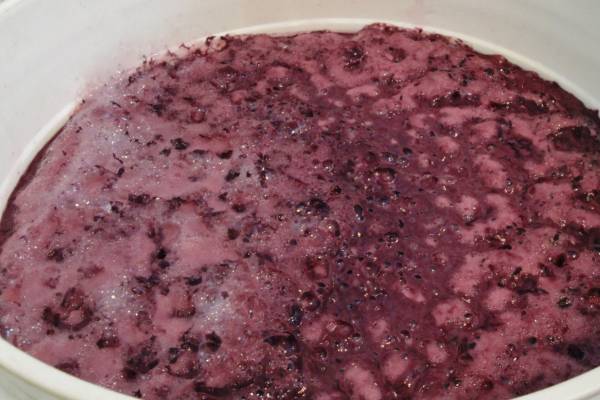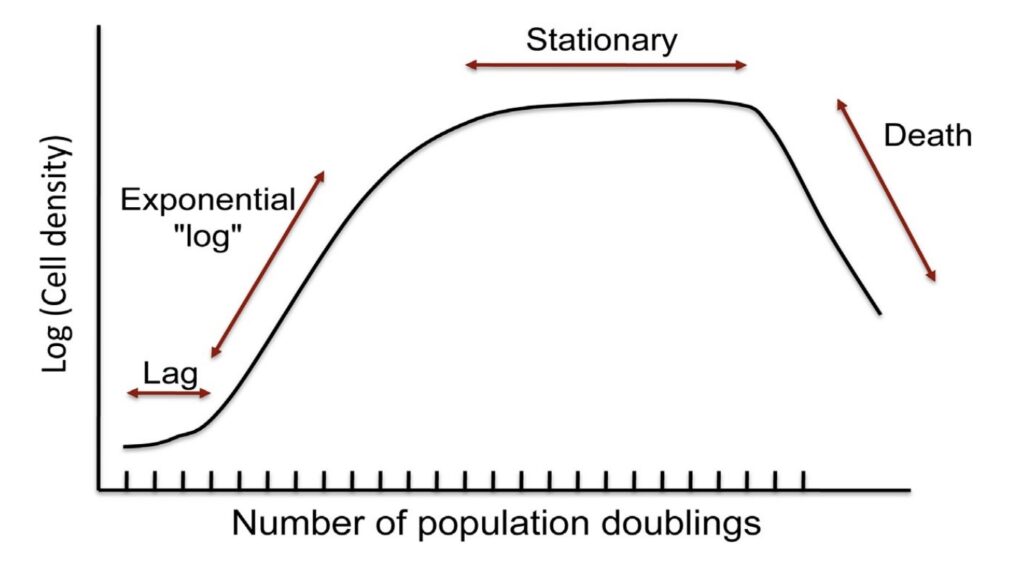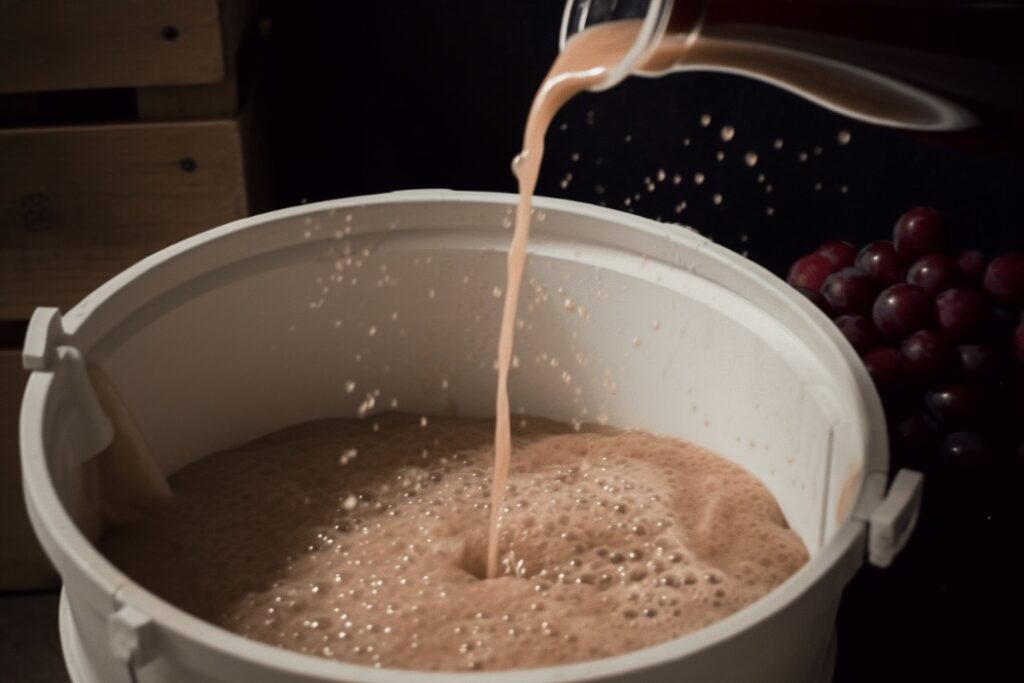Making wine, a delightful and time-honored alcoholic beverage crafted from fermented grapes, has been cherished for centuries.
Crafting wine is a straightforward process, but it necessitates the introduction of yeast to initiate the fermentation journey.
While adding an ample amount of yeast to your grape juice when commencing the winemaking process can kickstart fermentation and expedite the process, excessive yeast can lead to a rapid and turbulent fermentation, resulting in issues such as foaming, elevated temperatures, loss of aromatic compounds and overflow.
Moreover, an excessive yeast presence early in the process can give rise to undesirable flavors as the yeast rapidly dies off.
In essence, while it may be acceptable to introduce a substantial quantity of yeast into wine, it can potentially lead to challenges. It is crucial to employ the appropriate yeast quantity and contemplate the addition of yeast nutrients to ensure a healthy fermentation.
So, raise a glass of your favorite wine, and let’s delve into the world of winemaking!
The Ramifications of Excessive Yeast in Wine
Exceeding the recommended yeast quantity in winemaking can have adverse effects on the taste, aroma, and appearance of your finished product.

A surfeit of yeast can produce off-flavors and aromas, resulting in a higher alcohol content than desired, an increase in methanol levels, or excessive foaming that may lead to vessel overflow during fermentation.
Additionally, an overabundance of yeast can render the wine cloudy in appearance. Precise yeast management is vital to enhance the quality of your wine.
When determining the appropriate yeast amount for wine fermentation, factors such as the yeast strain, wine recipe, and fermentation temperature must be taken into consideration.
Excessive or inadequate yeast utilization can lead to undesirable consequences, such as unpleasant flavors, stalled fermentation, and excessive carbonation.
BUT!
It is crucial to remember that the majority of yeast in wine is not derived from the initial yeast addition but rather from yeast cells dividing during fermentation!

Typically, yeast doubles approximately ten times per day under ideal conditions. This process accelerates at the outset and gradually stabilizes into an equilibrium, where an equal number of yeast cells die and reproduce.
For instance, if you introduce 1 gram of yeast into a 1-gallon flask, assuming a maximum yeast density of 10^9 cells per ml (provided you have quality grape juice with added yeast nutrients!), you will have approximately 50mg of yeast per ml at the peak of fermentation (late log phase, as illustrated above!).
This equates to a final yeast weight of 0.05g x 3,785.41 milliliters = 189.27 grams of yeast mass at the zenith of fermentation (roughly!).
While these calculations are approximations, the key takeaway is that regardless of whether you initially add 1 or 10 grams of yeast, you will ultimately have at least 200 grams (7 oz) per gallon (53 grams per liter) in a supportive substrate.
The initial yeast quantity has minimal influence on this final number. However, it can impact the speed at which you reach that point.
If you are more interested in the mathematics behind yeast and fermentation speed, take a look at my slightly more nerdy post on whether adding more yeast will speed up fermentation (and how much!).
So, don’t agonize excessively about pitching the precise amount of yeast initially, but you might save some resources by not overusing yeast. In the worst-case scenario, you can always introduce additional yeast if you discover a fermentation stall.
Excessive Yeast in Wine Can Lead to Unpleasant Outcomes
Overloading your wine with too much yeast may result in unsavory off-flavors and aromas. An overabundance of yeast can overpower the natural flavors of your wine, producing a pronounced yeasty taste.

Introducing a significant quantity of yeast early in the process can expedite the breakdown of yeast cells, releasing metabolites, proteins, and DNA into the wine that can impact its flavor.
This can be especially problematic when utilizing specific yeast strains to enhance the wine’s taste or aroma. Furthermore, the byproducts of exuberant yeast activity can generate aromas ranging from bread-like or doughy to sulfurous or reminiscent of rotten eggs.
Ultimately, excessive yeast can disrupt the delicate equilibrium of flavors and aromas in your wine, underscoring the importance of judicious yeast utilization to prevent potential adverse outcomes.
Too Much Yeast Can Elevate Alcohol Content
When crafting wine, it is essential to consider the quantity of yeast you introduce, as excessive yeast can lead to unintended consequences.
One such consequence is an elevated alcohol content exceeding your desired level. An overabundance of yeast can extend fermentation beyond the necessary duration, resulting in wine with a higher alcohol by volume (ABV) than intended.
This can render the wine harsh and overly alcoholic, detracting from the desired flavor profile. Maintaining control over yeast levels is paramount to achieving the desired taste and alcohol content in your wine.
By monitoring yeast quantities and fermentation duration, you can ensure that your wine emerges with the perfect balance.
Excess Yeast Can Render Wine Cloudy
If you’ve ever poured a glass of wine and noticed it appeared hazy or cloudy, an excess of yeast may be the culprit. Abundant yeast can contribute to wine’s murkiness and unappealing visual aspect.

Clusters of inactive yeast cells tend to accumulate over time, particularly when a substantial quantity of yeast is introduced.
Not only does this affect wine’s appearance, but it can also impart off-flavors and aromas. Prudent yeast control is vital to crafting high-quality wine. It is imperative to ascertain the correct yeast pitching rates for your wine batch.
Excessive or insufficient yeast usage can lead to variations in alcohol content and affect the overall quality of your wine. In the end, a balanced yeast quantity will yield a clear and refreshing glass of wine.
When to Introduce Yeast into Wine – Timing Matters
In the realm of winemaking, timing plays a pivotal role in achieving the perfect blend of flavors and aromas. When deciding when to introduce yeast into your wine, temperature and acidity are critical considerations.

Wine yeasts thrive at temperatures between 60-75°F; therefore, it is essential to maintain your grape juice within this temperature range before introducing yeast.
Furthermore, ensuring your juice possesses an appropriate acidity level is crucial to fostering healthy yeast growth. Once your juice attains the correct temperature and acidity, it is time to incorporate your chosen yeast strain.
Be mindful of the quantity you introduce, as excessive yeast can lead to heightened alcohol content and off-flavors.
Ultimately, the key to successful wine fermentation lies in achieving balance – the right yeast quantity added at the right time can yield a delicious and well-rounded final product.
Rescuing Troubled Wine through Proper Acidity and Additional Active Yeast
If your wine tastes off or has ceased fermenting, it may be “troubled” due to an imbalance in acidity or an excessive addition of metabisulfite, rendering the yeast inactive.
However, fret not – by introducing the correct quantity of additional active yeast and adjusting acidity levels, you can salvage and revive your wine.

Firstly, evaluate your wine’s acidity using a pH meter or acid test strips, and make necessary adjustments using sodium bicarbonate (baking soda) or calcium. Ensure the pH remains above 3, as values below this can be problematic; add an alkalizing agent until the pH reads above 3.
Next, introduce a small amount of active yeast to kick-start fermentation, ensuring a clean, consistent flavor profile.
If excessive sulfite addition is the issue, “air out” your wine by gently transferring it between two vessels. This is best done
when the wine is stuck at the early fermentation stages, as excessive oxygen exposure is detrimental to later-stage fermentation.
With attentive care, even “troubled” wine can be revived and transformed into a delightful, refreshing beverage to savor.
Controlling Yeast Levels Enhances Wine Quality
Effectively managing yeast levels in your wine significantly enhances its overall quality. As previously mentioned, an excess of yeast can produce off-flavors, aromas, heightened alcohol content, and a cloudy appearance.
Conversely, insufficient yeast can lead to incomplete fermentation and a lack of desired flavors. By meticulously regulating yeast quantity in your wine, you can strike a balance that accentuates the inherent flavors of your grapes while achieving the desired alcohol content.
Furthermore, controlling yeast levels can help avert spoilage issues and other pitfalls encountered in winemaking. Therefore, do not underestimate the importance of exercising proper yeast control when crafting high-quality wine that is consistently delectable.
So, How Much Yeast Should I Use for Wine?
The ideal yeast quantity depends on various factors, including the volume of wine you are producing, the desired alcohol content, and the yeast strain employed.

Generally, 1 gram of yeast per gallon of wine is typically sufficient. However, for drier, higher-alcohol, or challenging-to-ferment wines, 2-3 grams per gallon may be acceptable.
It is crucial to bear in mind that the majority of yeast cells do not originate from the initial addition but rather proliferate during fermentation!
Finding the appropriate yeast pitching rate will elevate the overall quality of your wine. To ensure a successful fermentation process, add yeast when the wine is at room temperature, secure the stopper and airlock, and let nature work its magic.
Remember, in the realm of yeast and winemaking, moderation is key.
Factors to Contemplate When Determining Yeast Pitching Rates
When determining the appropriate yeast quantity to introduce to your wine, several factors warrant consideration. As mentioned earlier, excessive yeast can result in off-flavors, heightened alcohol content, and a cloudy appearance.
Conversely, insufficient yeast may lead to sluggish fermentation or even a halted fermentation.
The volume of your wine, specific gravity, and the desired alcohol content should all inform your yeast pitching rate decision.
Furthermore, it is vital to acknowledge that distinct yeast strains can impart varying effects on your wine’s taste and aroma.
By thoughtfully examining these variables, you can ascertain the optimal yeast pitching rate for crafting the highest quality wine.
Inadequate or Excessive Yeast Usage in Wine Production
Utilizing too little or too much yeast in wine production can have adverse repercussions on your wine’s overall quality. Overusing yeast can yield off-flavors and aromas, an elevated alcohol content, and a cloudy appearance.

Conversely, insufficient yeast can lead to sluggish fermentation and potentially foster unhealthy bacterial growth. Determining the right yeast quantity depends on several factors, including the desired alcohol content, temperature, and sugar levels of the wine.
An important point that I prove to you in my previous post, is that adding more yeas does not significantly improve fermentation speed. Or at least not for long!
By exercising precise control over yeast levels, you can enhance your wine’s overall quality and ensure a successful fermentation process.
Conclusion:
In the world of winemaking, yeast plays a crucial role in shaping the final product. As we’ve explored, while it’s essential to introduce yeast to initiate fermentation, striking the right balance is paramount. Too much yeast can lead to unwanted consequences, such as off-flavors, elevated alcohol content, and cloudy appearances, while too little can result in sluggish fermentation.
Here are the key takeaways:
- Balance is Key: Achieving a harmonious balance in yeast quantity is essential. General guidelines suggest around 1 gram of yeast per gallon of wine, but this can vary based on your specific goals and the type of wine you’re crafting.
- Timing Matters: When introducing yeast, consider the temperature and acidity of your grape juice. This will impact the health of your yeast and, consequently, the quality of your wine.
- Rescue Your Wine: If you encounter issues like off-flavors or stalled fermentation, it’s possible to salvage your wine with the right adjustments. Proper acidity levels and additional active yeast can breathe life back into a troubled batch.
- Quality Over Quantity: Controlling yeast levels isn’t just about quantity; it’s about ensuring the best quality wine possible. Carefully consider factors like the desired alcohol content and yeast strain to craft a wine that’s truly exceptional.
In your winemaking journey, remember that practice makes perfect. Experiment with different yeast strains, fermentation times, and quantities to discover the nuances of winemaking that suit your palate. And don’t be afraid to seek guidance from experienced winemakers or resources in the field.
Ultimately, the art of winemaking is a blend of science and passion. Embrace the process, learn from your mistakes, and savor the fruits of your labor. With patience and dedication, you can create wines that delight the senses and leave a lasting impression. Cheers to your winemaking adventure!
References
- https://journals.plos.org/plosone/article?id=10.1371/journal.pone.0188388
- https://www.homebrewtalk.com/threads/fellow-cider-makers-how-much-yeast-is-too-much.483507/
- https://www.reddit.com/r/Homebrewing/comments/j00v0o/added_too_much_yeast_to_my_cider_did_i_ruin_it/
- https://www.quora.com/Will-adding-more-sugar-or-yeast-to-my-homemade-cider-give-it-a-higher-alcohol-content-or-just-ruin-it
- https://tarbarrel.com.au/what-happens-if-you-add-too-much-yeast-to-your-brew/




